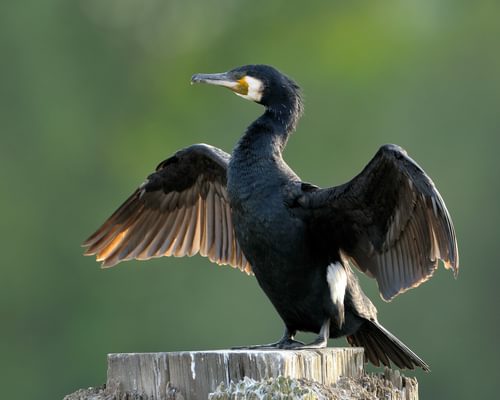There are 40 species in the cormorant and shag family Phalacrocoracidae, of which around 20 have the word ‘cormorant’ in their common name. Cormorants are prehistoric-looking aquatic birds with large, hooked bills and broad webbed feet and they live on practically every continent. Here, we’ll be answering the question: what do cormorants eat?
Cormorants are opportunistic predators that almost solely consume fish. Virtually every species of shag or cormorant consumes fish and aquatic animals such as shrimp, crustaceans, mollusks, crustaceans, and other shellfish, as well as the occasional octopus or squid. Most cormorants are generalists and feed upon whatever aquatic prey they can find in their feeding grounds.
Cormorants are exceptionally good at fishing and combine many techniques for catching prey, such as swallowing smaller prey whole when whooshing through shallow waters or diving to great depths to catch prey from the seafloor. The Imperial cormorant has been recorded diving to depths of 80m!
Due to their excellent fishing ability and at-times ravenous appetites, cormorants can pose a nuisance to fishers and anglers and anyone looking to maintain a fishery or pond. A large flock of cormorants can deplete a waterway of fish in mere hours!
Read on to learn more about the feeding habits and diets of these amazing fishing birds!
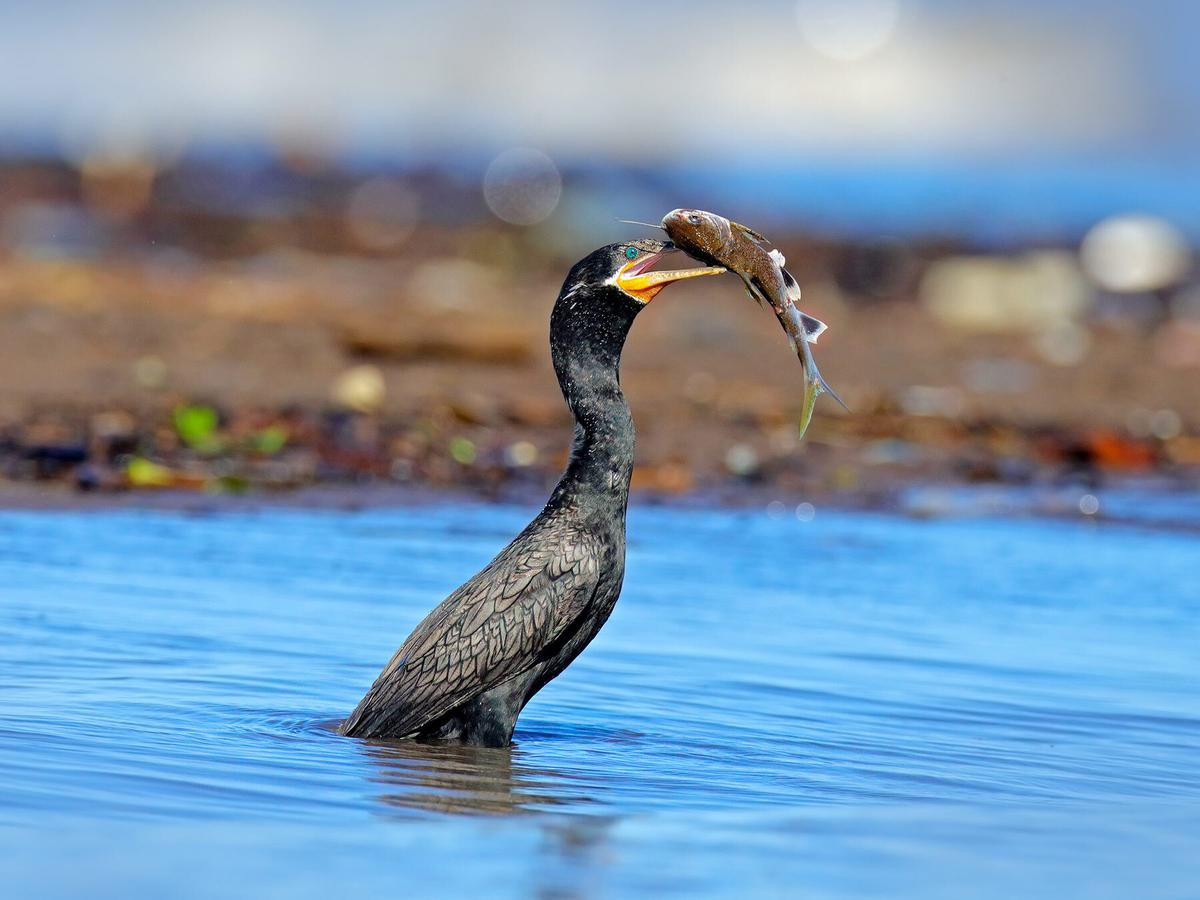
One of the main components of a Cormorants diet is fish
What types of fish do cormorants eat?
Cormorants eat any fish that they can feasibly catch and swallow. This includes practically any small to medium-sized fish that they access from their feeding grounds, including minnows, shad, herring, gobies, trout, perch, and panfish.
Cormorants are generalist predators and may feed on a wide range of fish or a comparatively small selection. For example, in France and Scotland, around 18 to 22 species of fish feature in a typical Great cormorant’s diet whereas, in North America, some cormorants feed on primarily salmon and salmonids at points throughout the year.
Some larger prey include pikes, Atlantic salmon, catfish, and carp. One Great cormorant was spotted swallowing a 9-inch Grass carp, and another was recorded capturing an Atlantic salmon weighing some 1.5kg or more! Large cormorants also eat eels and have been recorded catching very large specimens of up to 50cm long.
Smaller species of cormorants such as the Little and Pygmy cormorants eat a higher proportion of smaller fish and amphibians. For example, the Little cormorant eats tadpoles and young amphibians.
Flocks of cormorants can have devastating effects on fish populations. For example, in the Great Lakes region, cormorants can reduce the numbers of certain species of fish by some 80 to 90%.

A Great Cormorant catching a fish
How many fish does a cormorant eat in a day?
The Great cormorant typically aims to eat around 1lb (0.5kg) of fish per day. This might consist of 15 to 30 smaller fish items or just one larger catch.
While cormorants are capable of eating large prey, studies show that their average catch is below 20 cm in length (for the Great cormorant, at least). Large cormorants may consume some 30 fish in one day.
How do cormorants catch fish?
Cormorants primarily catch their prey by diving below the surface of the water, a technique called ‘pursuit diving.’ Prey is either swallowed whole or grasped in the beak, transported to land and then killed and eaten or swallowed alive. Cormorants have wide-opening mouths with hooked bills, which help them scoop and swallow fish efficiently, and their webbed feet help them maintain a high velocity through the water.
Most dives are quite shallow (1 to 2m deep), but some cormorants have been recorded diving to depths of 20m or more. The Imperial shag, or Imperial cormorant, has been recorded diving to an incredible depth of 80m, but max diving depths of 5 to 10m is more typical. Cormorants generally prefer to dive in clear waters, but foraging trips in muddy or unclear water are also successful.
Cormorants are flexible with regards to fishing, and some also pick fish and other prey from shallow waters rather than diving underneath the surface, though this is uncommon. They tend to forage in short bursts, launching some 10 to 25 diving trips in bouts ranging up to 25 minutes long. In the summer, Great cormorants spend some 5 hours fishing, but they might shorten bouts to just 45 minutes in winter.
Cooperative fishing
Cormorants usually fish alone in small or large flocks, but they have also been recorded hunting and feeding cooperatively. Cormorants will drive small schools of fish in-shore, where they’re easier to see and catch. The process will cycle until most cormorants are adequately fed.

Black cormorant diving for fish
How do cormorants find food?
Cormorants don’t generally have trouble finding food. They’ll flock to fish-abundant lakes, estuaries, rivers, reservoirs, and coastal environments and are capable of fishing in all manner of shallow and deep waters, fast-moving waters, and rocky pools.
Overall, most species of cormorants do prefer clear, slow-moving water, but they’re happy to fish from a wide range of habitats. Once a flock or colony of cormorants establishes a reliable feeding ground, they’ll return there after migration each year.
What time of day do cormorants feed?
Studies have revealed that cormorants feed primarily at dusk and dawn, and rarely in the late morning and mid-afternoon between the hours of 10:00 am and 3:00 pm. However, nighttime feeding has also been reported, too.
In the winter, cormorants are more likely to extend their feeding hours into the nighttime if they fail to catch anything in the daytime.
Overall, cormorants feed when fish are closer to the surface and easy to spot and when they’re less active and slower-moving, which is more common in the morning and at dusk. Nevertheless, as opportunistic predators, cormorants are mostly flexible with regard to when they feed.
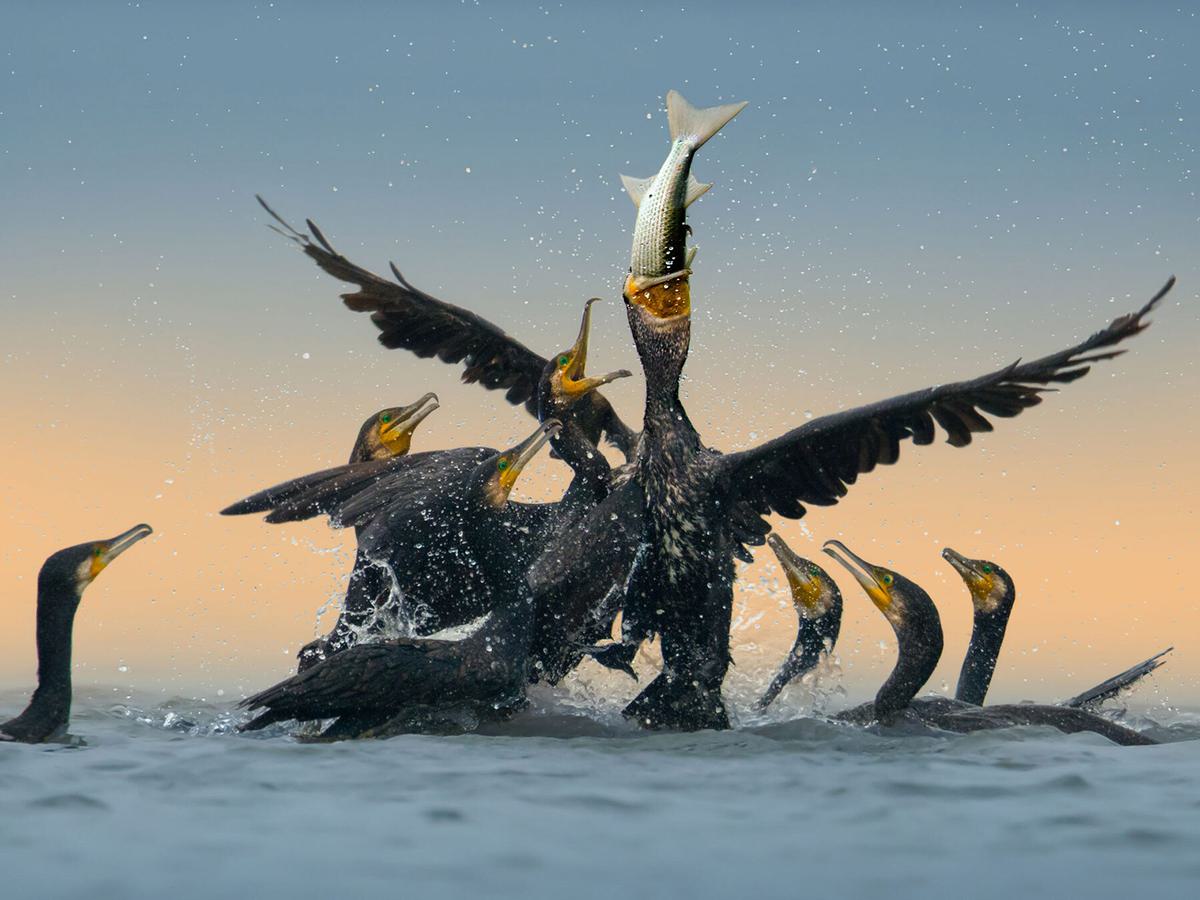
A group of cormorants fighting over a fish
What do cormorants eat in the winter?
Cormorant diets vary both regionally and seasonally, and they’ll eat whatever fish is available in their wintering grounds. This includes anything from salmon and herring to perch, minnows, stickleback, sunfish, carp, and catfish.
Cormorants eat less in the winter, but also perform less foraging trips to save energy as a result. While summer and spring foraging bouts can last many hours, Great cormorants in Norway cut their foraging time to less than 60-minutes a day, and often consumed less fish per day.
In North America, cormorants often visit in-land reservoirs during the winter, where they feed on catfish, shad, sunfish, and some freshwater crustaceans like crawfish.
What do cormorants eat in the summer?
Cormorants feed on a vast variety of fishing during the summer months. Different cormorants occupy different habitats and have different diets, though there is some crossover. For example, Double-crested cormorants in North America ate more eels in summer than Great cormorants, which consumed more non-eel fish.
Smaller cormorants such as the Little cormorant take advantage of spring and summer amphibian breeding, increasing their intake of tadpoles.
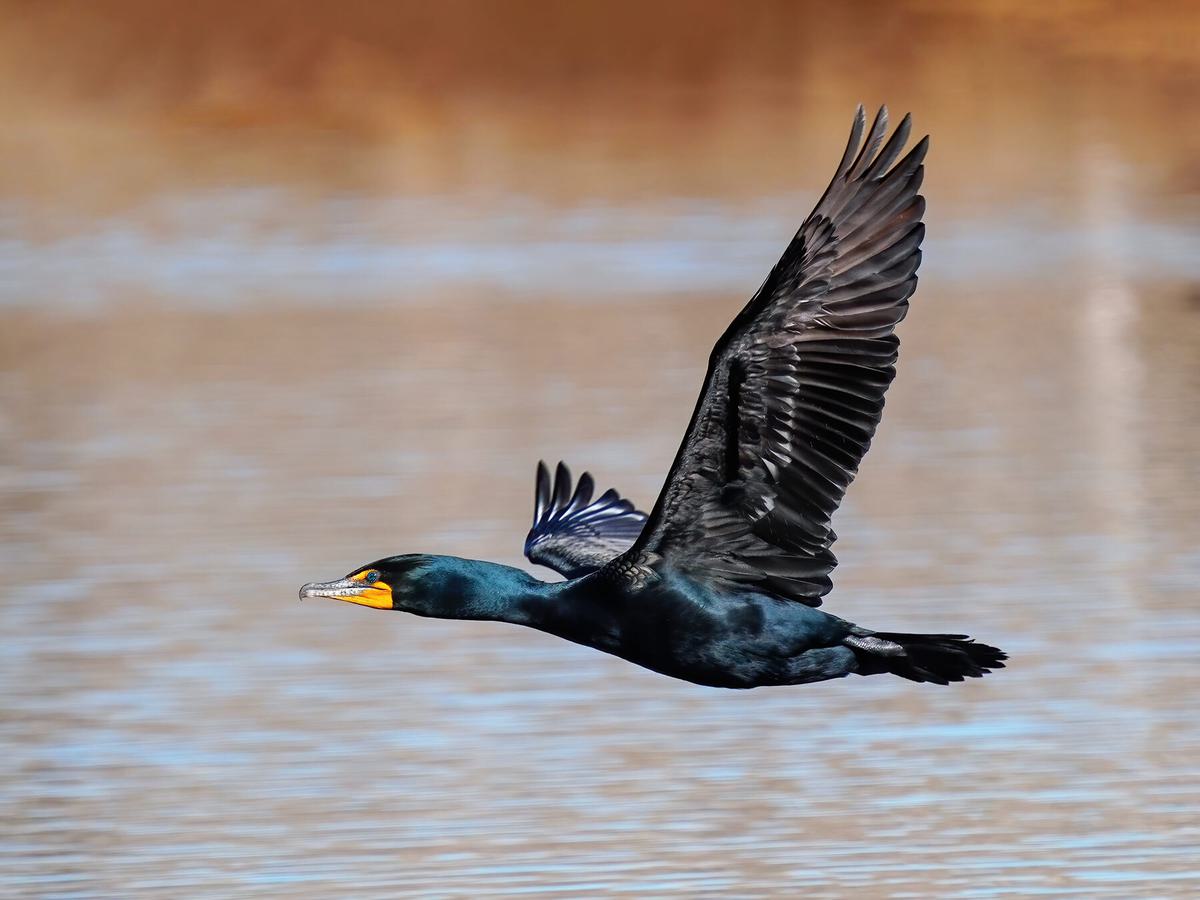
Double-crested cormorant (Phalacrocorax auritus) in flight
How do cormorants help fishermen?
Cormorants have been used for the purposes of traditional human fishing for thousands of years. Cormorant fishing involves tying a net to the bird's throat, which sets out to fish at sea.
The cormorant can still swallow small fish, but any larger fish are caught in the net tied around its neck - and can’t be swallowed. The bird then returns to the boat, where the fisherman removes the fish from its gullet.
While cormorant fishing used to be popular in some of Europe, e.g., North Macedonia and Greece, as well as in Japan and China, it’s quite uncommon now. However, some traditional fishermen still use the technique in China.
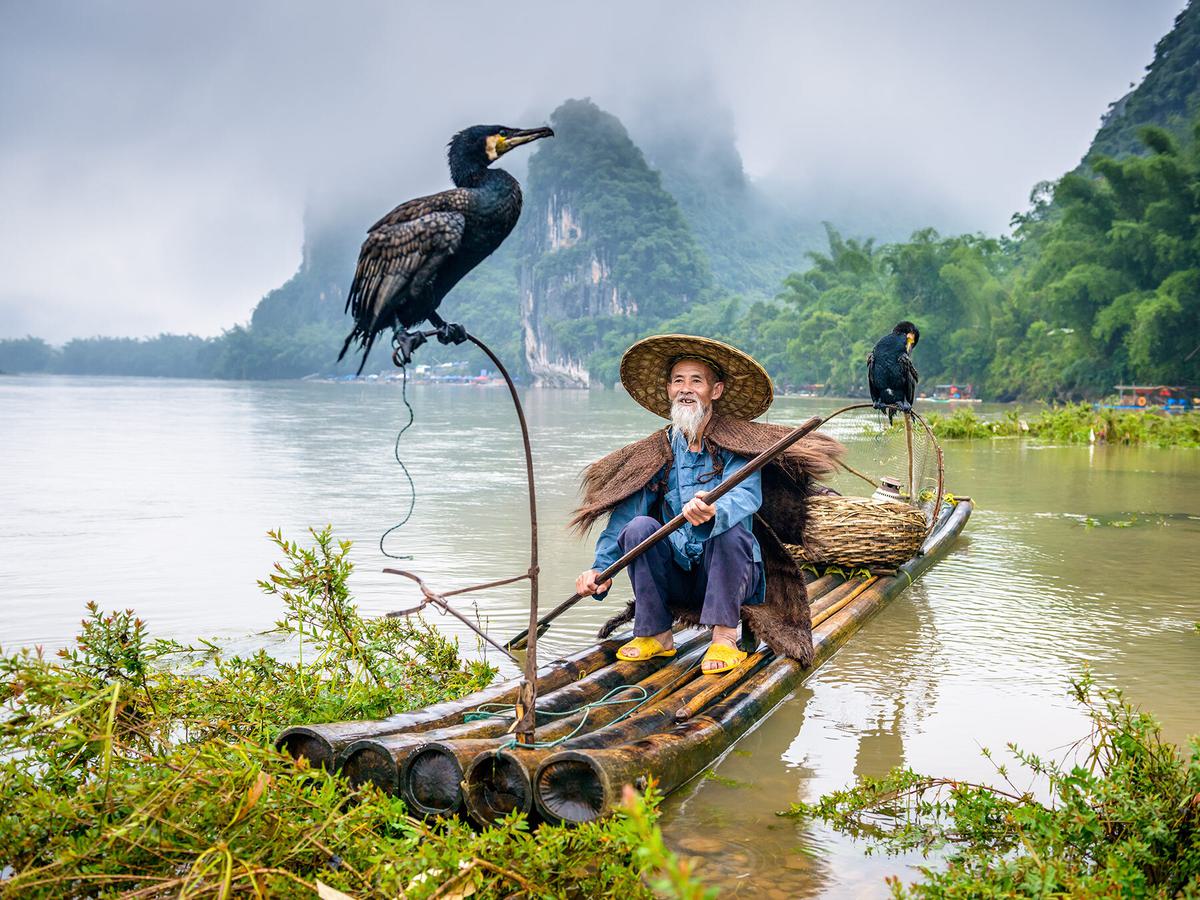
Cormorant fisherman and his bird on the Li River in Yangshuo, Guangxi, China
What do baby cormorants eat?
Baby cormorants are fed an array of fish and other aquatic animals. Their parents partially digest meals, and the chicks tend to reach into their mouths as they regurgitate it into their mouths.
Cormorants have large gular pouches and crops, which helps them store large amounts of food. Chicks have ravenous appetites and tend to eat 200 to 300 g of food a day (in the case of the Great cormorant).
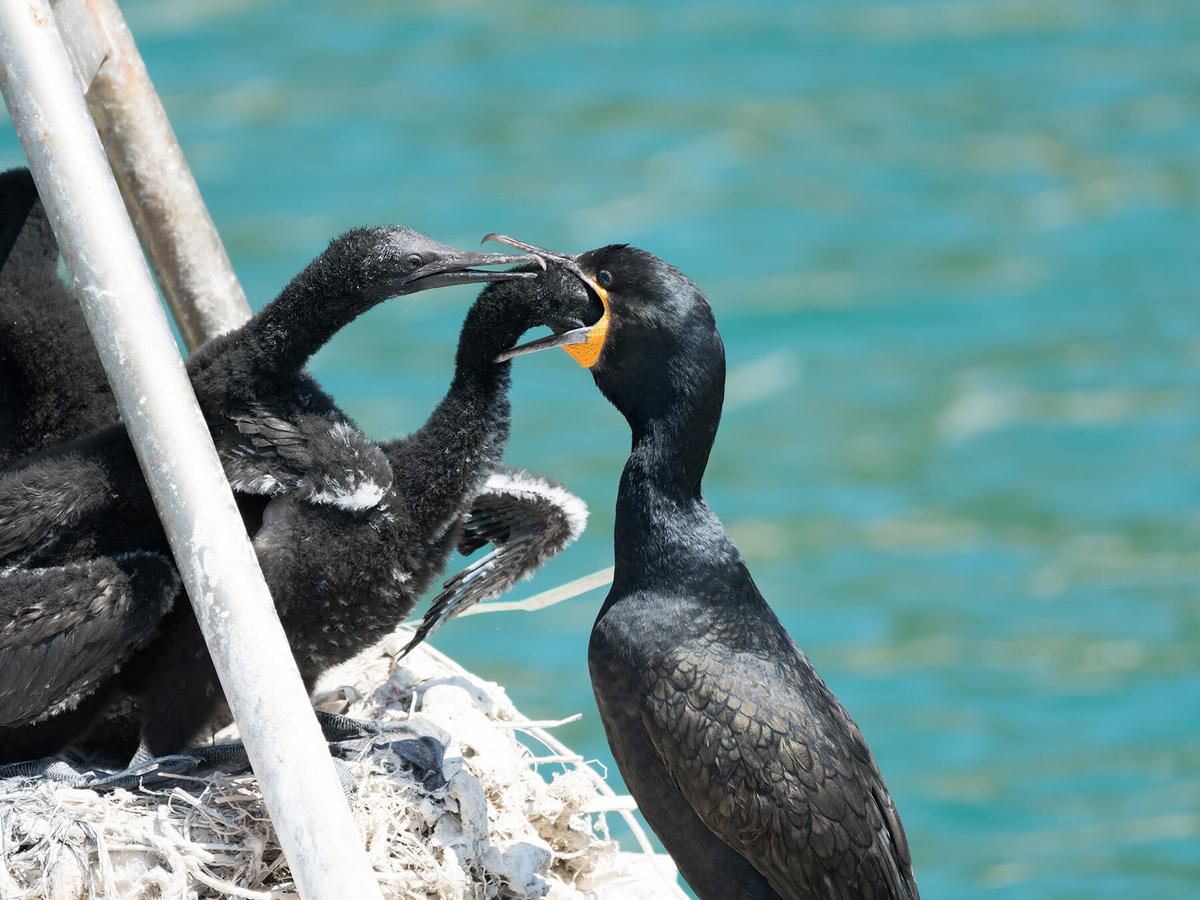
Cormorant feeding chicks
What do cormorants drink?
Cormorants drink water, and adults tend to get most of their water needs from feeding.
Since the chicks don’t dive themselves and are fed by their parents, they can get incredibly thirsty in hot climates. Cormorant chicks are known to beg for water, which the parents store in their gular pouch and crop and feed to them when they’re particularly thirsty.
Cormorant Diet FAQs
What do double-crested cormorants eat?
Double-crested cormorants primarily eat fish, but do also eat shellfish and even insects. Double-crested cormorants eat more eels than Great cormorants on average.
What do flightless cormorants eat?
The unique Flightless cormorant of the Galapagos has lost the ability to fly over the course of its evolution. However, its diet is still primarily piscivorous, consisting of fish, eels, octopuses, squid, and other aquatic animals.
Do cormorants eat snakes?
Cormorants are opportunistic predators and may feed on snakes present in their freshwater and coastal habitats. In addition, many snakes are strong swimmers and might be present in a cormorant’s feeding grounds.
Do cormorants eat ducklings?
Some species of cormorants have been recorded eating other birds, especially ducklings. However, this is uncommon.

A cormorant swallowing a fish
Do cormorants eat mackerel?
Cormorants certainly do eat mackerel, which makes up a good portion of their diet throughout some regions in Europe and North America.
Do cormorants eat turtles?
It’s unlikely that cormorants will eat turtles, and there’s no real evidence to suggest they do.
Do cormorants eat frogs?
Many species of cormorants do eat frogs, especially those that forage from shallow in-land waterways, lakes, and ponds.
Do cormorants eat crayfish?
Cormorants do eat crayfish and other shellfish, but crustaceans are not the main focus of their diets.

